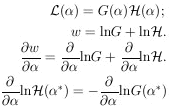


Usually it is a matter of taste what physical quantity is
chosen as  . For example, in
a lifetime experiment some workers would solve for the lifetime,
. For example, in
a lifetime experiment some workers would solve for the lifetime,
 *, while others would solve for
*, while others would solve for
 *, where
*, where
 =
1/
=
1/ . Some workers prefer to use
momentum, and
others energy, etc. Consider the case of two related physical
parameters
. Some workers prefer to use
momentum, and
others energy, etc. Consider the case of two related physical
parameters  and
and
 . The maximum-likelihood
solution for
. The maximum-likelihood
solution for  is
obtained from the equation
ðw / ð
is
obtained from the equation
ðw / ð = 0. The
maximum-likelihood
solution for
= 0. The
maximum-likelihood
solution for  is obtained
from
ðw / ð
is obtained
from
ðw / ð =
0. But then we have
=
0. But then we have

|
Thus the condition for the maximum-likelihood solution is
unique and independent of the arbitrariness involved in choice
of physical parameter. A lifetime result
 * would be related
to the solution
* would be related
to the solution
 * by
* by
 * =
1/
* =
1/ *.
*.
The basic shortcoming of the maximum-likelihood method is
what to do about the prior probability of
 . If the prior
probability of
. If the prior
probability of  is
G(
is
G( ) and the
likelihood function obtained for the experiment alone is
) and the
likelihood function obtained for the experiment alone is
 (
( ), then the joint likelihood
function is
), then the joint likelihood
function is

|
give the maximum-likelihood solution. In the absence of any
prior knowledge the term on the right-hand side is zero. In
other words, the standard procedure in the absence of any prior
information is to use a prior distribution in which all values
of  are equally
probable. Strictly speaking, it is impossible
to know a "true" G(
are equally
probable. Strictly speaking, it is impossible
to know a "true" G( ),
because it in turn must depend on its
own prior probability. However, the above equation is useful
when G(
),
because it in turn must depend on its
own prior probability. However, the above equation is useful
when G( ) is the
combined likelihood function of all previous experiments and
) is the
combined likelihood function of all previous experiments and
 (
( ) is the likelihood function of
the experiment under consideration.
) is the likelihood function of
the experiment under consideration.
There is a class of problems in which one wishes to determine
an unknown distribution in
 ,
G(
,
G( ), rather than a single
value
), rather than a single
value  . For example, one may
wish to determine the momentum
distribution of cosmic ray muons. Here one observes
. For example, one may
wish to determine the momentum
distribution of cosmic ray muons. Here one observes

|
where  (
( ; x) is known from the
nature of the experiment and
G(
; x) is known from the
nature of the experiment and
G( ) is the function to be
determined. This type of problem is discussed in Reference 5.
) is the function to be
determined. This type of problem is discussed in Reference 5.